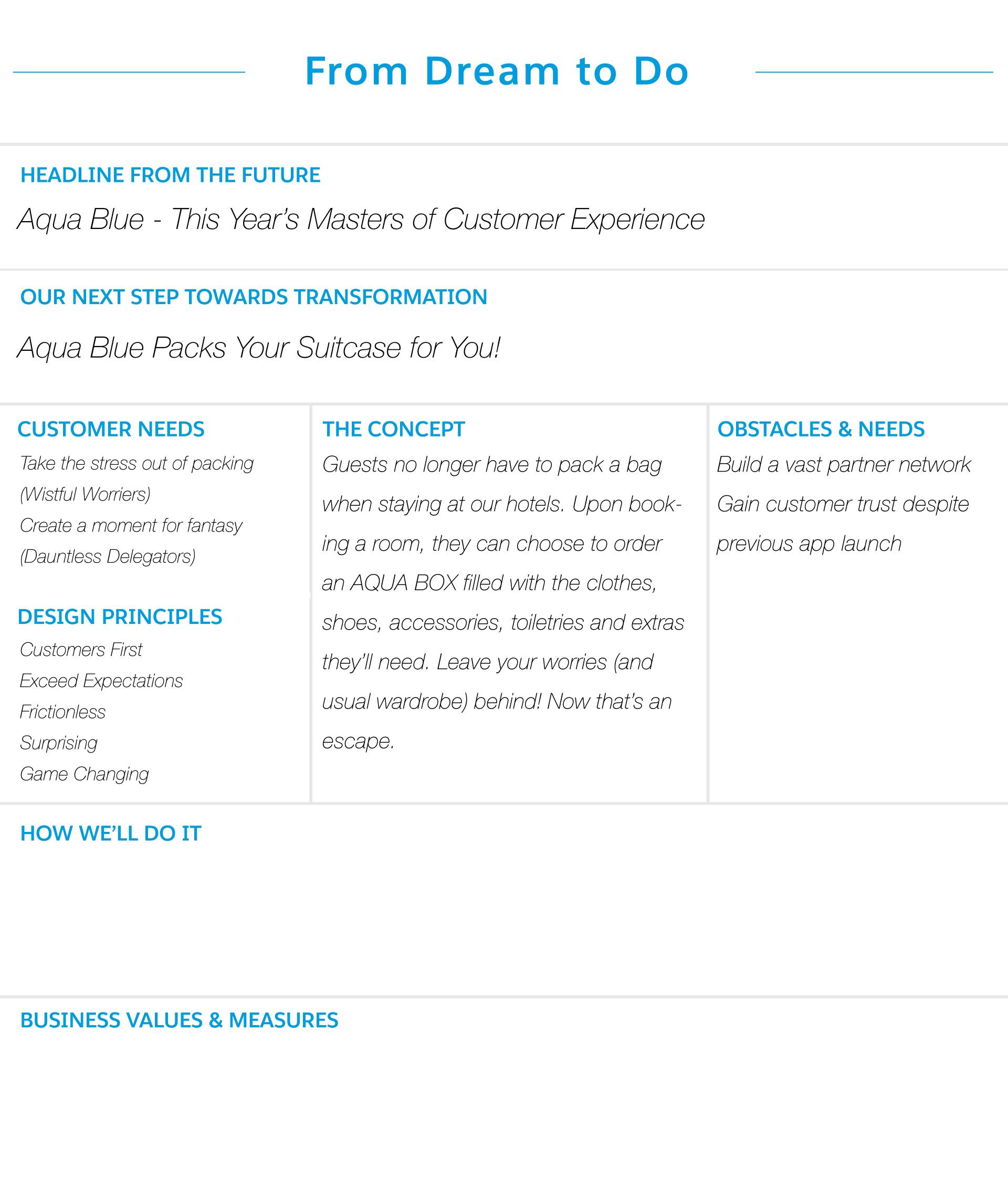Clarify Your Concept and Proposal
Learning Objectives
After completing this unit, you’ll be able to:
- List the components necessary to create a winning proposal for your innovation project.
- Describe what’s included in the Dream to Do framework.
- List the elements of an effective concept description.
The Do Phase
Congratulations! You just developed an amazing concept for your organization, and it’s going to be wildly successful out of the gate, right? Well … maybe.
Coming out of your Dare events, while the energy is high about the vision you created, it’s normal to feel as though you don’t have all the details worked out. That’s why it’s time for the Do phase.
In our experience, within a few weeks of your Dare events, your executive sponsor will be eager to hear a full proposal around the project that answers:
- What’s the idea?
- What customer-centric problem does it solve?
- How does it work?
- What’s its business value?
- How do you implement it?
- How much does it cost?
It’s much like the criteria caregivers use when their child has “an incredible learning opportunity” next summer that they want to talk about. Proceed with caution until further details are provided.
We recommend that when it comes time to deliver that proposal, include these three components to show that you’ve done your homework.
- Advanced prototype
- Business case for change
- Implementation plan
If you’re not usually the one who is tasked to build a product or determine the cost and execution plan for a project, don’t worry. That’s why you assembled your council of makers—the more technical members of your organization who can help you dive into the details.
Your job is not necessarily to provide all the answers but to ask the right questions and involve the right people to help you tell a compelling story to sell your idea. This story will not only captivate your customer the way an effective advertisement does, but also excite your CEO, CFO, CMO, COO, and every single employee in the organization.
So let’s dive into the “need to know” info for making each component of your proposal as successful as possible.
Build an Advanced Prototype
Start with your prototype, because it’s at the center of your vision. Revisit the themes and good ideas that surfaced from your Dare events and ensure that there’s clarity around the steps of the experience.
More important than the features, or even screens of your wireframe, is a well-crafted, compelling story. The story reflects the pains and opportunities of your leading customer archetypes.
The Aqua Blue team chooses to dramatize the pain of the wistful worriers and dauntless delegators by creating a product demo based around a mom who has a demanding job that requires lots of travel. Whether the kids are at home or with her on a trip, she is always forgetting things she needs. She would prefer taking a break than worrying about packing for herself and the family.
This type of setup creates an emotional connection with your audience.
When you have a story that you like, think about the level of fidelity—or how close to “real”—you need for an effective prototype. Depending on your capabilities and resources, a dynamic presentation consisting of slides might be enough. If your audience is a tech team, they might be more compelled by a clickable prototype or a live demo built in an org.
Find out the expectations and then use your steering committee and core team to deliver a product that excites.
From Dream to Do
With the prototype in process, you can now establish the foundation of the business story. Back in the second module, “Innovation Project Definition,” we leveraged the Salesforce V2MOM technique to create a charter for your innovation project. Since then, you’ve evolved your concept much further and now your V2MOM might be out of date. Instead of updating it, we recommend evolving it to become a Dream to Do sketch.
Uh oh, more jargon. Stick with us. This tool is helpful.
At the core of your Dream to Do sketch is a succinct articulation of your concept. It helps you indicate what it is, who it’s for, what it does, and why it matters. You should be able to do that based on the Shark Cage pitch that the winning team delivered during your dare sessions.
Here’s Aqua Blue’s Dream to Do sketch.

Headline from the future: Aqua Blue—This Year’s Masters of Customer Experience
Next step toward transformation: Aqua Blue Packs Your Suitcase for You!
Concept:
Guests no longer have to pack a bag when staying at our hotels. Upon booking a room, they can choose to order an Aqua Box filled with the clothes, shoes, accessories, toiletries, and some extras they’ll need. Leave your worries, and usual wardrobe, behind. Now that’s an escape!
Customer needs:
- Take the stress out of packing (Wistful Worriers)
- Create a moment for fantasy (Dauntless Delegators)
Design principles:
- Customers first
- Exceed expectations
- Frictionless
- Surprising
- Game changing
Obstacles:
- Build a vast partner network
- Gain customer trust despite previous app launch
In the next unit, we go through tips on how to complete the rest of the pieces that speak to implementation and business value. Before that, we present some tips to turn your paper prototype into a more advanced product vision.